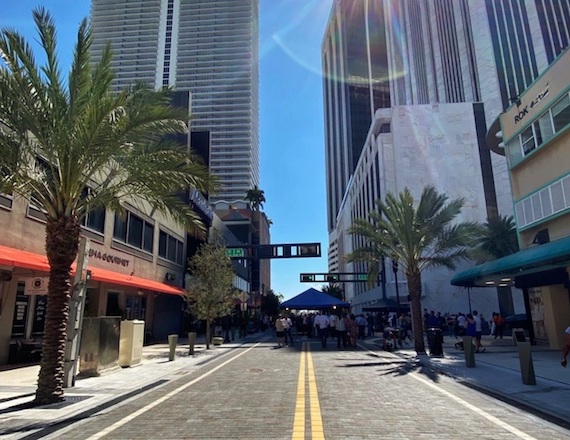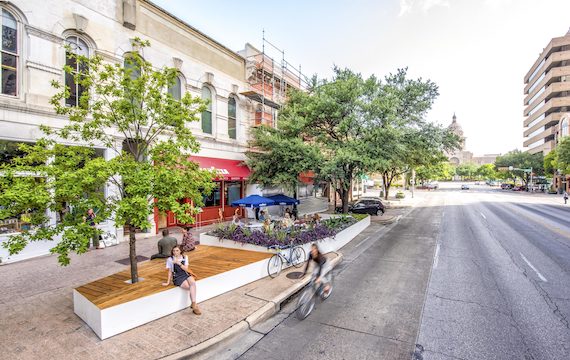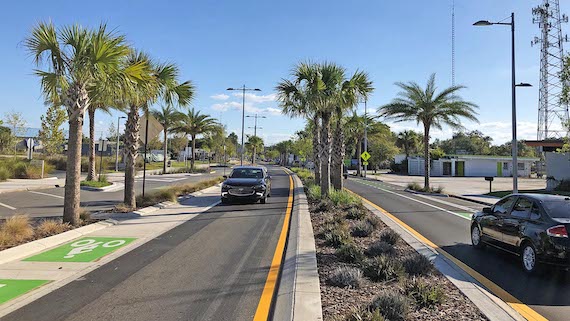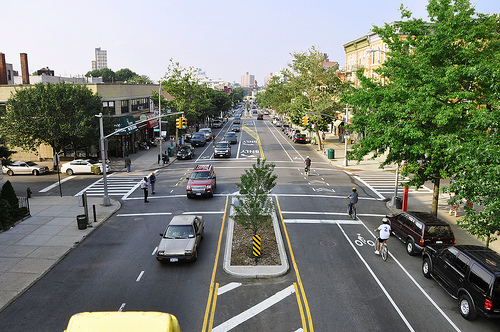
Identify traffic and safety issues in less time with Urban SDK traffic management software.

sales@urbansdk.com

support@urbansdk.com

(904) 337-9836
A definitive guide to the urban planing philosophy of Complete Streets
Complete Streets is centered around creating roadways that are designed to accommodate the needs of all users, including pedestrians, cyclists, motorists, and public transportation users. The concept of Complete Streets aims to move away from the traditional approach of designing streets solely for vehicular traffic and instead focuses on creating a safer, more accessible, and inclusive transportation network.
The philosophy of Complete Streets recognizes that streets are not just thoroughfares for vehicles but also vibrant public spaces that should prioritize the well-being and mobility of all individuals. It promotes the idea that streets should be designed to accommodate a variety of transportation modes and users, regardless of age, ability, or mode of transportation chosen.
Pedestrian safety and accessibility are at the forefront of Complete Streets. This principle involves ensuring that streets have well-maintained sidewalks with adequate widths to accommodate pedestrians, including those using mobility aids.
Crosswalks are clearly marked and strategically placed to facilitate safe crossings, and pedestrian signals help regulate traffic to prioritize pedestrian movement. Curb ramps are provided to ensure accessibility for individuals with disabilities, and other features such as raised crosswalks or pedestrian islands may be incorporated to enhance safety.
Complete Streets prioritize the needs of cyclists by including dedicated bicycle infrastructure. This can include protected bike lanes physically separated from vehicular traffic, bike paths or greenways separate from roadways, or shared bike lanes marked with appropriate signage.
Adequate signage, markings, and signals are implemented to guide cyclists and ensure their safety. Additionally, amenities like bike parking racks or facilities at key destinations encourage cycling as a convenient and sustainable mode of transportation.
To facilitate the use of public transit, Complete Streets incorporate features that support its integration into the transportation network. This can involve designated bus lanes that prioritize transit vehicles, allowing for faster and more reliable service.
Transit stops and shelters are strategically located, providing safe and convenient access for passengers. Real-time transit information may be displayed at stops or integrated into smart transportation systems to enhance the overall transit experience.
While Complete Streets prioritize non-motorized transportation, they also consider the needs of motorists. Traffic calming measures, such as speed humps or roundabouts, are implemented to reduce vehicle speeds and enhance safety.
Appropriately sized lanes and intersection design help ensure efficient vehicle flow and minimize congestion. Intersection improvements, such as pedestrian refuge islands or dedicated turning lanes, are incorporated to enhance safety for all users.
Complete Streets take into account the surrounding land use and context to create streets that are tailored to their specific environment. This can involve incorporating elements that enhance the overall aesthetics, such as street trees, landscaping, or public art installations.
Streets may be designed to be more inviting and pedestrian-friendly in commercial or residential areas, while accommodating higher volumes of traffic in transportation corridors. The design and layout of the street consider the unique characteristics and needs of the surrounding community to create a harmonious blend of functionality and aesthetics.
By embracing these key principles, Complete Streets aim to create a transportation network that is safe, accessible, and convenient for all users, regardless of their mode of transportation. This holistic approach fosters healthier and more sustainable communities, improves mobility options, and enhances the overall quality of life for residents and visitors alike.

Complete Streets initiatives involve collaboration among various professionals to ensure the successful planning, design, and implementation of a comprehensive transportation network. The key professionals involved in Complete Streets include:
Urban planners play a crucial role in developing overall transportation strategies and policies that prioritize Complete Streets. They analyze the existing infrastructure, land use patterns, and community needs to create comprehensive plans that integrate transportation networks with other aspects of urban development.
Transportation engineers provide expertise in designing and engineering the physical infrastructure of Complete Streets. They are responsible for creating road designs that incorporate the necessary elements to accommodate pedestrians, cyclists, public transit, and vehicles safely and efficiently. They consider factors such as traffic flow, road geometry, signage, signals, and safety measures.
Landscape architects contribute to the aesthetic and environmental aspects of Complete Streets. They work on integrating green spaces, street trees, plantings, and other landscaping elements that enhance the overall appearance and functionality of the streetscape. They also consider stormwater management, urban heat island effects, and other sustainable design principles.
Civil engineers are involved in the construction and maintenance of the physical infrastructure required for Complete Streets. They provide expertise in structural engineering, drainage systems, utilities, and other technical aspects to ensure the durability and functionality of the street design.
Traffic safety experts focus on analyzing and improving safety for all users within the Complete Streets framework. They conduct traffic studies, assess potential hazards, and recommend appropriate traffic calming measures, signage, and signalization to enhance safety. Their input helps to minimize conflicts between different modes of transportation and reduce the risk of accidents.
Public engagement specialists facilitate community involvement and stakeholder input throughout the planning and implementation process. They organize public meetings, workshops, surveys, and focus groups to gather feedback, address concerns, and ensure that the Complete Streets design reflects the needs and preferences of the community.
Policy and decision makers, including city officials, elected representatives, and transportation agencies, play a vital role in adopting and implementing Complete Streets policies. They create the regulatory framework, allocate funding, and make strategic decisions to prioritize Complete Streets in transportation planning and projects.
Collaboration among these professionals, along with input from community members and advocacy groups, is essential to achieve the goals of Complete Streets. By working together, they can create safe, accessible, and sustainable transportation networks that enhance the livability and connectivity of communities.

Data plays a crucial role in creating and improving Complete Streets. Here are some types of data commonly used:
This includes data on traffic volumes, speeds, and patterns, collected through traffic counts, automatic traffic recorders, or vehicle tracking systems. This data helps engineers understand the existing traffic conditions and identify areas that require improvements to accommodate multiple modes of transportation.
Data on pedestrian and bicycle movements, such as counts and travel patterns, help identify high-demand areas and inform the design of pedestrian and bicycle infrastructure. This data can be collected through manual counts, automated counters, or mobile tracking apps.
Analyzing crash data provides insights into areas with high rates of collisions involving pedestrians, cyclists, or motor vehicles. This data helps identify potential safety hazards and inform targeted interventions, such as improving crosswalks, installing traffic calming measures, or enhancing visibility.
Understanding land use patterns, population density, and demographic information is critical for designing Complete Streets that cater to the needs of the community. This data helps determine where transportation investments are most needed and assists in prioritizing areas with high pedestrian and cyclist activity or underserved populations.
Data related to accessibility, including sidewalk condition assessments, availability of curb ramps, and transit accessibility, informs the identification of barriers to mobility and aids in designing streets that are accessible to all users, including those with disabilities.
Data on public health indicators, such as rates of physical activity, obesity, or chronic diseases, can help make the case for investing in Complete Streets as a means of promoting active transportation and improving community health outcomes.
Gathering input from the community through surveys, public meetings, or online platforms provides valuable qualitative data. It helps identify local needs, preferences, and concerns regarding street design and guides decision-making to ensure that Complete Streets reflect the desires and aspirations of the community.
By analyzing and leveraging these types of data, transportation professionals and planners can make informed decisions, prioritize investments, and continuously evaluate the performance of Complete Streets. This data-driven approach enables the creation of safer, more accessible, and efficient transportation networks that meet the evolving needs of communities.

Overall, the economic benefits of Complete Streets include increased property values, thriving local businesses, improved business vitality, enhanced tourism, cost savings, reduced healthcare costs, job creation, and sustainable development. Here's a deeper look how that happens.
Complete Streets enhance the attractiveness and desirability of neighborhoods, leading to increased property values. Streets that prioritize safety, walkability, and accessibility attract more residents and businesses, which can positively impact real estate prices and stimulate economic growth.
Complete Streets create an environment that encourages walking and cycling, increasing foot traffic and visibility for local businesses. Pedestrian-friendly infrastructure, wider sidewalks, outdoor seating areas, and enhanced streetscapes attract shoppers and boost sales for retailers, restaurants, and cafes along the street.
Complete Streets often feature enhanced amenities, such as street furniture, public art, and green spaces. These elements create an appealing and welcoming atmosphere that attracts people to spend time in commercial areas, leading to increased economic activity, higher customer satisfaction, and repeat business.
Complete Streets with attractive design, vibrant streetscapes, and pedestrian-oriented features can attract tourists and visitors. These individuals contribute to the local economy by spending money on shopping, dining, and entertainment, which boosts tourism-related businesses and generates revenue for the community.
Complete Streets that promote active transportation, such as walking and cycling, can improve public health outcomes.
By encouraging physical activity and reducing reliance on cars, Complete Streets contribute to healthier lifestyles, leading to potential reductions in healthcare costs associated with sedentary behavior and related chronic diseases.
Complete Streets can lead to cost savings in the long run. Investments in pedestrian and cycling infrastructure, such as sidewalks, bike lanes, and crosswalks, are generally more affordable compared to expanding road capacity for cars.
Additionally, Complete Streets that promote walking, cycling, and public transit can help reduce congestion and decrease the need for costly road expansion projects.
Complete Streets projects often require skilled labor for construction, landscaping, and infrastructure improvements. Implementing and maintaining Complete Streets can create job opportunities, providing employment and stimulating the local economy.
Complete Streets support sustainable development by reducing greenhouse gas emissions and promoting efficient land use. By prioritizing active transportation and public transit, communities can reduce reliance on private cars, resulting in savings on fuel costs and a more sustainable transportation system.
By creating vibrant, accessible, and people-centric streets, Complete Streets contribute to the economic prosperity and well-being of communities.

The following examples demonstrate how Complete Streets initiatives have been implemented to create safer, more accessible, and vibrant transportation corridors.
By incorporating elements that cater to all modes of transportation and considering the unique characteristics of each location, these projects have successfully transformed streets into inclusive and people-centric spaces.
Flagler Street, located in downtown Miami, underwent a transformation as part of a Complete Streets initiative. The project included widening sidewalks, adding shade trees and landscaping, installing pedestrian-scale lighting, and improving crosswalks with enhanced safety features. The redesigned street now provides a more pedestrian-friendly environment, encouraging walking and supporting local businesses.
Orange Avenue, a major thoroughfare in downtown Orlando, was redesigned as a Complete Street to accommodate various modes of transportation. The project involved adding protected bike lanes, expanding sidewalks, and incorporating transit amenities, including dedicated bus lanes and shelters. These improvements have enhanced safety and accessibility for pedestrians, cyclists, and public transit users, while still maintaining efficient vehicular movement.
The 606, also known as the Bloomingdale Trail, is an elevated multi-use trail converted from an old railroad line. It serves as a prime example of a successful Complete Street project, providing dedicated spaces for walking, jogging, and cycling.
The trail incorporates green spaces, public art installations, and seating areas, creating a vibrant and accessible community space.
Main Street in downtown Gainesville underwent a Complete Streets redesign to prioritize pedestrians, cyclists, and public transit. The project included wider sidewalks, enhanced crosswalks, bike lanes, and improved transit facilities.
These enhancements have revitalized the downtown area, making it more inviting and accommodating for all users. As such, it extended the vibrancy of the college town eastward, connecting the city's downtown with the University of Florida, and making it easier for students to travel beyond campus.
West Trinity Place in Decatur was transformed into a Complete Street with a focus on walkability and active transportation. The redesign included widened sidewalks, bike lanes, and improved pedestrian crossings.
Additionally, traffic calming measures and enhanced streetscape features were incorporated, creating a safer and more attractive corridor for residents and visitors — providing a slower-paced alternative to the hustle of Atlanta's BeltLine
Congress Avenue in Austin underwent a Complete Streets redesign, prioritizing pedestrian and cyclist safety and improving the overall streetscape. The project included wider sidewalks, dedicated bike lanes, improved landscaping, and outdoor seating areas.
These enhancements have transformed Congress Avenue into a vibrant and pedestrian-friendly corridor, supporting economic vitality and community engagement.

The future of Complete Streets holds several exciting possibilities as cities and communities continue to prioritize safety, sustainability, and equitable transportation.
Technology will play a significant role in the future of Complete Streets. Intelligent transportation systems, connected vehicles, and smart infrastructure will enable real-time data collection and analysis to improve traffic flow, enhance safety, and provide personalized travel information.
Smart traffic signals, adaptive street lighting, and sensor-based infrastructure will optimize the use of transportation networks and enhance the overall efficiency of Complete Streets.
There will be an increased emphasis on equity in the design and implementation of Complete Streets. Future initiatives will strive to ensure that transportation networks serve all residents, regardless of age, income, ability, or location.
This includes prioritizing accessibility for individuals with disabilities, improving transit access in underserved communities, and addressing transportation barriers faced by disadvantaged populations.
Complete Streets will continue to promote and integrate sustainable transportation options. This includes prioritizing and expanding infrastructure for walking, cycling, and public transit.
Electric vehicle charging stations, bike-sharing programs, and car-sharing services may become more prevalent as cities transition to cleaner and greener transportation options. Integration with emerging mobility technologies, such as electric scooters or autonomous vehicles, will also be explored to enhance the overall transportation system.
Future Complete Streets will incorporate climate resilience strategies to mitigate the impacts of climate change.
This may involve integrating green infrastructure elements like permeable pavements, rain gardens, and tree plantings to manage stormwater and reduce heat island effects. Complete Streets will be designed to withstand extreme weather events and adapt to changing environmental conditions.
Future Complete Streets will continue to prioritize community engagement in the planning and design process. Meaningful engagement with residents, businesses, and community organizations will ensure that the street design reflects local needs, cultural preferences, and aspirations.
Placemaking elements, such as public art installations, pocket parks, and outdoor gathering spaces, will be integrated into Complete Streets to create vibrant and attractive community spaces.
The future of Complete Streets will rely heavily on data-driven decision making. Advanced analytics, machine learning, and predictive modeling will be utilized to assess the performance of transportation networks, evaluate safety measures, and identify areas for improvement.
Data from connected vehicles, mobile apps, and sensors will guide proactive decision-making to optimize the operation and management of Complete Streets.
Overall, the future of Complete Streets envisions transportation networks that prioritize safety, accessibility, sustainability, and community engagement. By embracing technological advancements, promoting equity, and integrating sustainable practices, Complete Streets will continue to evolve and create vibrant, livable, and people-centric communities.